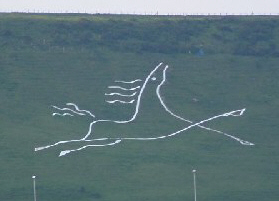Folkestone White Horse facts for kids
The Folkestone White Horse is a giant white horse shape carved into the side of Cheriton Hill in Folkestone, Kent, South East England. It's a special type of artwork called a hill figure, made by removing grass to show the white chalk underneath. This impressive horse looks out over the English entrance to the Channel Tunnel. It was finished in June 2003.
Contents
Why Was the White Horse Built?
The idea for the Folkestone White Horse came about as a "Millennium Landmark." This meant it was planned around the year 2000 to celebrate the new millennium and help improve the Folkestone area. The goal was to bring new life and interest to the town.
The Design and Inspiration
A local artist named Charlie Newington created the design for the horse. He got his ideas from a few places:
- An ancient Iron Age fort nearby, in an area called Horse Hill, which is thousands of years old.
- The famous Uffington White Horse, another ancient hill figure in England.
The Folkestone White Horse is the first official hill figure in the town. Interestingly, there's also a natural chalk area on Summerhouse Hill that people say looks like an elephant's head, and it's known as the Folkestone Elephant.
The Journey to Build the Horse
Building the White Horse wasn't easy! It took several years of planning and discussions before construction could begin.
Getting Permission
The first request to build the horse was made in April 1998. To show what it would look like, a large canvas outline of the horse was put up in August 1999.
However, the project faced some challenges:
- Environmental Concerns: A government group called English Nature was against the project. They were worried because the site was a Site of Special Scientific Interest (SSSI). This means the area is very important for its wildlife and natural features.
- Public Support: Despite the environmental worries, many local people and politicians, like MP Michael Howard, supported the project. The local council, Folkestone and Hythe District Council, even made the horse their official symbol.
Because of the disagreements, a public meeting was held in 2001 to decide if the project should go ahead. In March 2002, the government officially approved the project. They decided that the horse's emotional and symbolic value for the community was more important than the possible environmental impact.
How the Horse Was Built
Work on the horse started in September 2002. All the construction was done by hand!
- Staking Out: Volunteers, guided by the artist using radios, laid out a second canvas outline of the horse on the ground.
- Digging Trenches: Shallow trenches, about 30–60 centimeters (12–24 inches) wide, were dug into the topsoil following the outline.
- Filling with Limestone: These trenches were then filled with white limestone slabs.
The entire horse figure is about 90 meters (almost 300 feet) long, measured from its front to its back hoof.
Challenges and Completion
Even after construction began, there were still some challenges.
Environmental Groups' Concerns
Two environmental groups, the Green Party and Friends of the Earth, asked the European Union to stop the project. They argued that the site was protected under a rule called the European Habitats Directive. In May 2003, the EU officially told the UK government that the work might be illegal. They gave the government two months to explain their decision or restore the site. By this time, the grass for the horse had already been cut and moved.
Finishing the Horse
Over two weeks in May 2003, a team of volunteers worked hard to finish the horse. This team included local Gurkha soldiers. They carried, cut, and carefully placed the limestone slabs into the trenches, holding them in place with pins. The work of laying the limestone had been delayed earlier because the Gurkhas were helping to drive fire engines during a firefighters' strike in 2002–2003. The limestone laying was completed in early June 2003, even with the EU's concerns still ongoing.
Looking After the Horse
In June 2004, a group called "The Friends of the Folkestone White Horse" was created. Their job is to promote the landmark and take care of the site, which needs regular light weeding to keep the horse clear. A time capsule was buried at the site on June 18, 2004, to be opened in the future.
Images for kids



